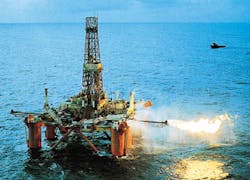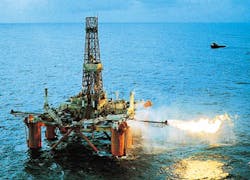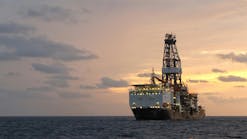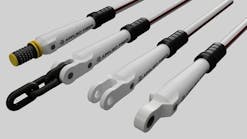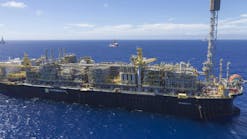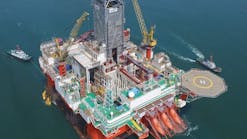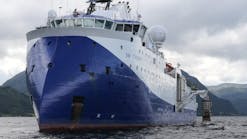Deepwater development: the next decade
T.M. Bourgeois, D.G. Godfrey, M.J. Bailey
Shell International
Deepwater Services B.V
The offshore industry should be able to drill and produce in 3,500-meter water depths by the year 2008.
- Examples of deepwater production systems. [106,121 bytes]
- The once-significant water depth gap between the ability to evaluate and drill for oil and gas in deepwater and the ability to develop is expected to close in the years come. [38,043 bytes]
What a change we have seen in 10 years. Early deepwater developments in the GOM with floating production systems (floating production systems or FPS, and tension leg well platforms or TLWP) were technical successes, but commercially disappointing, due to poorer than expected reservoir performance.
Shell set ever increasing water depth records for TLP's from Auger to Mars to Ram-Powell (981 meters) and for subsea gas developments from Tahoe to Popeye to Mensa (1616 meters).
Highly productive turbidite reservoirs and new completion methods have yielded deepwater production rates an order of magnitude greater than those achieved on the GOM Shelf. These successes have encouraged more operators to bid on leases in the GOM and around the world. Aggressive exploration programs to evaluate the acreage have driven up rig rates by a factor of 2-3.
In 1998, we see development activities in at least five geological areas outside the GOM: Brazil, West of Shetlands, West Africa, Australia, and Northern North Sea. Industry seems to be in a frenzy of deepwater activity (competition for new acreage acquisition, new field developments and even new rig construction).
However, conditions have again changed rapidly. Oil prices are the lowest in a decade and industry rationalization is occurring through mergers and alliances.
Given the turbulence, excitement and success of deepwater activities in the last decade, what will the next decade bring? The only forecast we can make with certainty is that our characterization of where the E&P industry will be in 10 years will be wrong. But we can look to the past and our current capabilities and opportunities to help us predict what future success may look like.
The location and type of deepwater developments will be determined by economic imperatives. Future deepwater progress and the success of the exploration and production industry in deepwater will depend on our ability to create opportunities and adapt to change. Societal pressures and a low oil price environment will challenge our ability to create the commercially and technically sound development solutions needed to make deepwater a sustainable growth area.
Ingredients for success
Development opportunities for each company will be limited by access to prospective acreage. The ability to develop the acreage will be influenced by the availability of sufficient experienced staff, access to affordable technology, availability of infrastructure, and societal expectations. We will share our thoughts on the nature of future opportunities, technology development needed to commercialize the opportunities, and the potential impact of other factors.Development systems over the last 10 years have progressed, for economic reasons, from fixed structures, which resist the environment through rigidity, to floating structures: tension leg platforms (TLP); FPS units; floating production, storage, and offloading systems (FPSO), and spars, which accommodate the environment through flexibility.
This decade has witnessed many developments. Shell has installed the deepest fixed platform (Bullwinkle), the deepest, largest gravity based, concrete structure (Troll), a succession of TLP's and subsea developments in the GOM, and several FPSO's around the world. Placid and Petrobas installed deepwater FPS's, Conoco a TLWP at Jolliet, and Oryx and Chevron installed Spars at Neptune and Genesis, respectively.
Shell also partnered with BP for the installation of two FPSO's - Foinaven and Schiehalion - West of Shetlands for deepwater production system examples. This progress has been enabled by not only significant advances in subsurface evaluation, but also more cost-effective design and construction of production systems.
Improvements in subsurface evaluation have resulted from improved seismic data acquisition and processing, and from improvements in static and dynamic reservoir simulation models. Key factors in these developments have been rapidly evolving computer power and modelling techniques.
Access growth
Access to deepwater acreage has grown from primarily the Gulf of Mexico and offshore Brazil to include licenses off Northern Europe, West Africa, and the Far East. The Gulf of Mexico has seen significant development activities in the 1,000-meter water depth range as a result of highly productive turbidite reservoirs, improved drilling and completion practices, and cost effective development systems connected to an existing infrastructure of oil and gas pipelines.Construction costs and cycle time have been improved by significantly overlapping design and fabrication activities. This has been achieved by using alternative contracting approaches which seek to align objectives, share risk and incentives, improve communication, and encourage joint decision making.
Owner/contractor management steering teams and integrated site teams have facilitated behavior and cultural change. Different companies have used various approaches to try to improve working relationships and business results, including various forms of alliancing.
Future opportunities
Licensing of deepwater acreage has increased lately as successes in the Gulf of Mexico, Campos Basin, and West of Shetlands have encouraged operators to look for growth opportunities in deepwater. The result of operators requesting resource holders to offer acreage, and the resource holders viewing the deepwater as a revenue opportunity, has been a substantial increase in available acreage. Strong competition has pushed up lease bonuses/work commitments and is leading to opportunities in even deeper water.Most of the prospective deepwater acreage in water depths up to 1,500 meters is already leased and an estimated 10% of the prospective acreage between 1,500 and 3,500 meters has been leased. We believe that by 2008, most of the remaining deepwater acreage will have been leased.
Key prospective areas are, of course, West Africa, Brazil, Gulf of Mexico/Caribbean, and Australasia. Potential water depth opportunities, however, are probably limited to ± 3,500 meters in the next 10 years, as there is increasing doubt about the suitability of geological conditions for commercial hydrocarbon volumes in water depths beyond about 3,500 meters.
The other aspect of future deepwater opportunities is the development of smaller discoveries. This will require technology development as well as new approaches to development and is an important challenge because discovery of smaller fields will outnumber the world-class discoveries.
Operators and resource holders will have to find ways of cooperating, including across-country boundaries, because the commercial imperatives of cost reduction/sharing, commingling production, and development of common infrastructure will be required for development. Besides using economies of scale to reach minimum thresholds, different commercial terms and approaches will be needed to enable developments which will benefit all parties.
Water depth history
The move into deeper and deeper water has taken place over the last 40 years (see accompany figure). There has been a significant lag between our ability to evaluate and explore and our ability to develop.- In the last decade, exploratory drilling has progressed only 62 meters, from 2,258 meters of water in 1988 to 2,320 meters of water today. However, drilling rigs are under construction which will allow us to drill in up to 3,000 meters in the next few years.
- Given our view of available leasehold/concession opportunities and an extrapolation of capability (see accompanying figure), it seems reasonable to expect exploration drilling in 3,500 meters by 2008.
- Deepwater production has increased from Shell's Cognac platform in 313 meters of water to Petrobras FPSO in 1,420 meters of water in the Marlim Sul field with a subsea well producing from 1,709 meters of water.
Deepwater barriers
The barriers (see accompanying table) to deepwater require application of technology to find new and different solutions. These barriers arise from technical challenges and societal expectations which create economic hurdles to deepwater development. Solutions to these barriers will not only enable deepwater development but wll also provide technology which makes marginal shallow water fields commercial.- Low margin drilling conditions: As water depth increases, the long column of fluid in the drilling riser reduces the margin between pore pressure and fracture gradient. This creates a potential for lost circulation and inability to control near-seabed shallow water flow conditions.
- Development of riserless drilling systems to solve this problem is underway and will be proven technology within 10 years. Riserless drilling in combination with "slender well design" will reduce deck loads and extend the capability of smaller rigs into deepwater.
- Spanning the water column: Mooring systems, production risers, drilling risers, pipelines and flowlines, and control umbilicals all must span the distance from the seabed to a surface facility. As water depth increases, external pressure, environmental forces, and longer lengths require thicker, heavier components to limit stresses, which results in larger structures to support the component loads. Installation of production systems in deeper water will also require larger, more complex installation equipment. All of these factors increase costs. Taut mooring systems will be used to reduce movement, as well as costs of floating systems. Lighter weight riser systems will result from improved analytical techniques and the use of composite or synthetic materials. Lighter weight components in combination with new buoyancy designs and materials will reduce the size of the surface structures. Hybrid riser systems will reduce complexity and installation difficulty. In addition, we will see more application of artificial seabed designs to place critical areas below the point of significant wave influence.
- Flow assurance: Water temperature in deep water is barely above freezing. This leads to potential blockages in tubing, flowlines/ pipelines, and risers due to hydrate formation and increased wax (paraffin) deposition. More deepwater experience will provide data to calibrate analytical techniques. This will allow improved predictions which, in conjunction with preventive measures (designer chemicals), will enable longer tiebacks from subsea wells.
- Well productivity/reliability: High rate/high ultimate (HR/HU) wells are key to improving deepwater profitability. Completion designs have reduced skin and increased wellbore inflow leading to higher rates. Horizontal and multi-lateral wells will become even more prevalent to improve rates and reduce well counts. Optimizing well placement will result from better seismic interpretation and reservoir modeling. Costs will be reduced by using expandable tubulars to achieve equivalent flow diameters for smaller diameter wells. "Smart" completions will increase reliability through improved monitoring of well performance data. Other methods for improving production rates, ultimate production, and costs will involve moving equipment closer to the wellbore. This includes seabed/downhole separation, multiphase boosting, and artificial lift by improved electrical submersible pumps. Gas disposal: In remote areas, with no gas pipeline infrastructure or gas market, disposal of associated gas is required in order to produce oil. We do not design new facilities for flaring of gas today, except in emergency conditions, and within the next decade, society will expect all of industry to take positive steps to avoid flaring. Currently gas disposal is achieved by reinjection into subsurface reservoirs. Future methods are expected to include floating LNG plants and conversion of gas to liquids (syncrude).
- Global/local issues: Balancing global efficiency with local development will be a key challenge. The technology and experience necessary for safe, reliable deepwater development is currently concentrated in a few locations worldwide. Scarcity of expertise will impact operators ability to carryout a large number of simultaneous projects. Effective use of scarce staff resources and maximizing learnings transfer from project to project encourage the use of global teams. This requires improved communication systems and organizational alignment. This approach, however, conflicts with the desire of many resource holders for technology transfer, development of local industry, and improved balance of payments. Solution of these conflicting objectives, such as development/use of local industry, will be necessary for timely, cost effective development and will be particularly difficult in a low oil price environment.
- Risk management: Deepwater operations are conducted in a difficult environment and the consequence of a mistake can be serious and costly. There are few options available to remedy mistakes. Experienced staff, specialized expertise, careful planning and attention to detail are required. Management of risk involves adequate training and preparation of contingency plans particularly for drilling and producing operations. As regulators and society at large become more aware of deepwater developments in their backyard, we can expect to have to demonstrate our safety management capability and that we have the technical and financial strength to cope with deepwater challenges.
Survivors
The next 10 years will be full of unexpected changes. The successful deepwater operators will be the ones which can adapt to the unexpected, whether it be political change, price fluctuation, or new technology. The path to the future contains many challenges.We know we can drill in 2,500 meters water depth today and have technical solutions for production systems moored in 2,300 meters of water. We are confident the technology can be safely extended to drill and produce in 3,500 meters of water.
The challenge is finding ways of doing it profitably in an uncertain oil price environment and for smaller field sizes. Success will require, more than ever before, a systems engineering approach and full integration of all the subsurface and surface engineering skills to improve field development planning, management of uncertainty, and project execution.
Many of the current sequential, approval-driven work processes (with JV partners and government agencies) will be replaced by new ways of working together on deepwater projects in order to enable improved cycle time, cash flow and project economics. The exploration and production survivors will be the companies that can create future opportunities through innovation, new relationships, and social responsibility.
Authors
T. M. Bourgeois is the General Manager of Shell International Deepwater Services B.V.; D. G. Godfrey is the Development Planning Process Manager; M. J. Bailey is the Technology Leverage Process Manager. The organization is located in The Hague, The Netherlands.
Copyright 1998 Oil & Gas Journal. All Rights Reserved.
